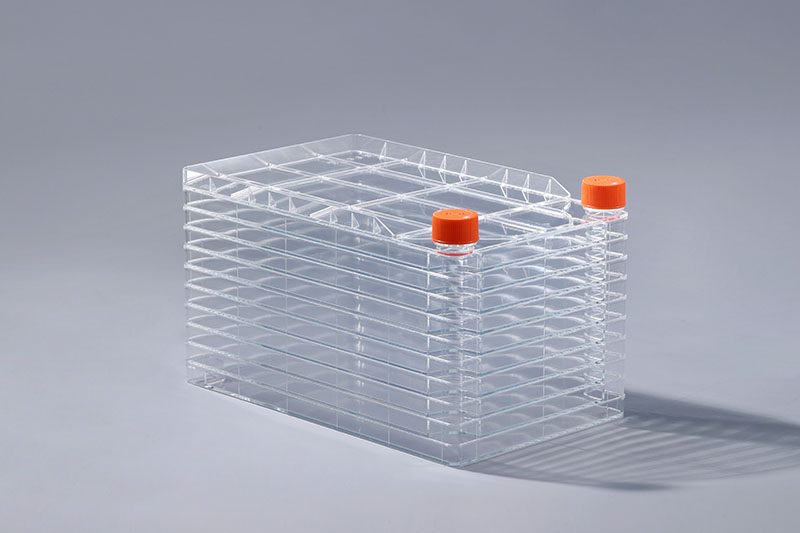সাম্প্রতিক বছরগুলিতে, জৈবিক পণ্য শিল্পের দ্রুত বিকাশের জন্য ধন্যবাদ, কোষ সংস্কৃতি প্রযুক্তি মনোক্লোনাল অ্যান্টিবডি এবং ভাইরাস ভ্যাকসিন পণ্যগুলির ক্ষেত্রে ব্যাপকভাবে ব্যবহৃত হয়েছে। অনেক সংস্কৃতি পদ্ধতির মধ্যে, cell factory সংস্কৃতি প্রযুক্তি হল একটি সাধারণ বৃহৎ আকারের সেল কালচার পদ্ধতি, যার নিম্নলিখিত সুবিধা রয়েছে:
1। জনশক্তি, বস্তুগত সম্পদ, সময় এবং স্থান সংরক্ষণ করুন।
সেল ফ্যাক্টরির চাষের ক্ষেত্রটি স্থানের সর্বাধিক ব্যবহার করতে পারে, যার ফলে কর্মশালার প্রচুর স্থান সংরক্ষণ করা যায় এবং একটি নির্দিষ্ট পরিমাণে জনশক্তি এবং বস্তুগত সম্পদ সংরক্ষণ করা যায়। এটি স্বয়ংক্রিয় কোষ সংস্কৃতি উপলব্ধি করতে এবং শ্রমের তীব্রতা এবং তীব্রতা ব্যাপকভাবে হ্রাস করতে স্বয়ংক্রিয় অপারেটিং সরঞ্জামের সাথে সংমিশ্রণে ব্যবহার করা যেতে পারে।
2। স্কেল আপ করার জন্য সুবিধাজনক
সাধারণ সংস্কৃতি পদ্ধতিতে, আপনি যদি কোষ সংস্কৃতির স্কেল প্রসারিত করতে চান তবে আপনি কোষের ভোগ্য সামগ্রীর সংখ্যা বাড়াবেন। সংখ্যা বাড়ানোর সময়, এটি আরও স্থান এবং জনবল নেয়। সেল ফ্যাক্টরি কালচার প্রযুক্তি সংস্কৃতির স্কেল বাড়াতে চায়, যা সহজেই সেল ফ্যাক্টরি স্তরের সংখ্যা বৃদ্ধি করে অর্জন করা যায়, যা সুবিধাজনক এবং দ্রুত।
3। দূষণের কম ঝুঁকি
যেহেতু ব্যবহৃত সেল ফ্যাক্টরিতে একটি বৃহত্তর কালচার এরিয়া রয়েছে, সেহেতু সেল কালচারের যন্ত্রপাতি কমে যায় এবং দূষণের ঝুঁকি কমে যায়। অনেক সুবিধার কারণে এই প্রযুক্তিটি ভ্যাকসিন শিল্প, স্টেম সেল কালচার, কোষের গুণমান এবং মনোক্লোনাল প্রস্তুতিতে ব্যাপকভাবে ব্যবহৃত হয়েছে।
সেল কারখানাcell factory culture technology, and it is precisely because of many advantages that this technology has been widely used in the vaccine industry, stem cell culture, cell quality, and monoclonal preparation.
The FAI climbed 5.9 percent year-on-year in the first 11 months of 2018, quickening from the 5.7-percent growth in Jan-Oct, the National Bureau of Statistics (NBS) said Friday in an online statement.
The key indicator of investment, dubbed a major growth driver, hit the bottom in August and has since started to rebound steadily.
In the face of emerging economic challenges home and abroad, China has stepped up efforts to stabilize investment, in particular rolling out measures to motivate private investors and channel funds into infrastructure.
Friday's data showed private investment, accounting for more than 60 percent of the total FAI, expanded by a brisk 8.7 percent.
NBS spokesperson Mao Shengyong said funds into weak economic links registered rapid increases as investment in environmental protection and agriculture jumped 42 percent and 12.5 percent respectively, much faster than the average.
In breakdown, investment in high-tech and equipment manufacturing remained vigorous with 16.1-percent and 11.6-percent increases respectively in the first 11 months. Infrastructure investment gained 3.7 percent, staying flat. Investment in property development rose 9.7 percent, also unchanged.
 English
English



















































